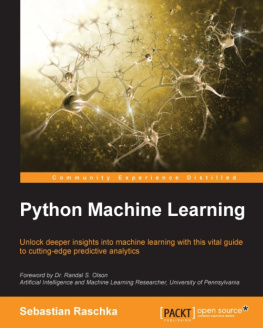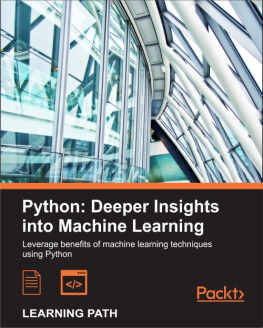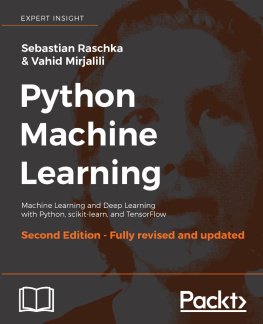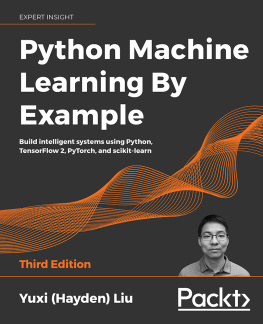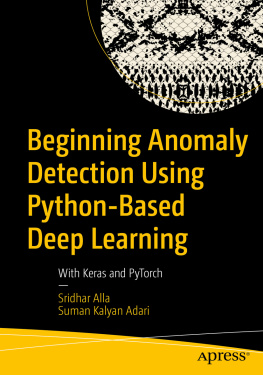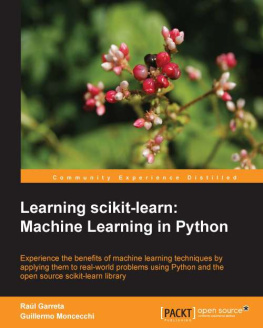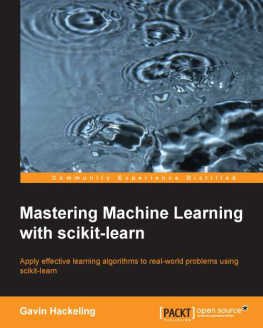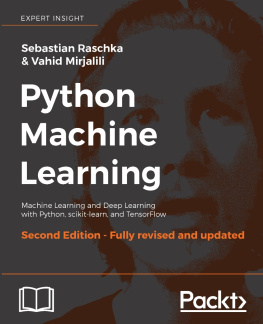Sebastian Raschka - Machine Learning with PyTorch and Scikit-Learn
Here you can read online Sebastian Raschka - Machine Learning with PyTorch and Scikit-Learn full text of the book (entire story) in english for free. Download pdf and epub, get meaning, cover and reviews about this ebook. year: 2022, publisher: Packt, genre: Children. Description of the work, (preface) as well as reviews are available. Best literature library LitArk.com created for fans of good reading and offers a wide selection of genres:
Romance novel
Science fiction
Adventure
Detective
Science
History
Home and family
Prose
Art
Politics
Computer
Non-fiction
Religion
Business
Children
Humor
Choose a favorite category and find really read worthwhile books. Enjoy immersion in the world of imagination, feel the emotions of the characters or learn something new for yourself, make an fascinating discovery.
- Book:Machine Learning with PyTorch and Scikit-Learn
- Author:
- Publisher:Packt
- Genre:
- Year:2022
- Rating:4 / 5
- Favourites:Add to favourites
- Your mark:
- 80
- 1
- 2
- 3
- 4
- 5
Machine Learning with PyTorch and Scikit-Learn: summary, description and annotation
We offer to read an annotation, description, summary or preface (depends on what the author of the book "Machine Learning with PyTorch and Scikit-Learn" wrote himself). If you haven't found the necessary information about the book — write in the comments, we will try to find it.
Machine Learning with PyTorch and Scikit-Learn — read online for free the complete book (whole text) full work
Below is the text of the book, divided by pages. System saving the place of the last page read, allows you to conveniently read the book "Machine Learning with PyTorch and Scikit-Learn" online for free, without having to search again every time where you left off. Put a bookmark, and you can go to the page where you finished reading at any time.
Font size:
Interval:
Bookmark:

Machine Learning with PyTorch and Scikit-Learn
Develop machine learning and deep learning models with Python
Sebastian Raschka
Yuxi (Hayden) Liu
Vahid Mirjalili

BIRMINGHAMMUMBAI
Python and the Python Logo are trademarks of the Python Software Foundation.
Machine Learning with PyTorch and Scikit-Learn
Copyright 2022 Packt Publishing
All rights reserved. No part of this book may be reproduced, stored in a retrieval system, or transmitted in any form or by any means, without the prior written permission of the publisher, except in the case of brief quotations embedded in critical articles or reviews.
Every effort has been made in the preparation of this book to ensure the accuracy of the information presented. However, the information contained in this book is sold without warranty, either express or implied. Neither the authors, nor Packt Publishing or its dealers and distributors, will be held liable for any damages caused or alleged to have been caused directly or indirectly by this book.
Packt Publishing has endeavored to provide trademark information about all of the companies and products mentioned in this book by the appropriate use of capitals. However, Packt Publishing cannot guarantee the accuracy of this information.
Producer: Tushar Gupta
Acquisition Editor Peer Reviews: Saby Dsilva
Project Editor: Janice Gonsalves
Content Development Editor: Bhavesh Amin
Copy Editor: Safis Editing
Technical Editor: Aniket Shetty
Proofreader: Safis Editing
Indexer: Tejal Daruwale Soni
Presentation Designer: Pranit Padwal
First published: February 2022
Production reference: 3220222
Published by Packt Publishing Ltd.
Livery Place
35 Livery Street
Birmingham
B3 2PB, UK.
ISBN 978-1-80181-931-2
www.packt.com
Over recent years, machine learning methods, with their ability to make sense of vast amounts of data and automate decisions, have found widespread applications in healthcare, robotics, biology, physics, consumer products, internet services, and various other industries.
Giant leaps in science usually come from a combination of powerful ideas and great tools. Machine learning is no exception. The success of data-driven learning methods is based on the ingenious ideas of thousands of talented researchers over the fields 60-year history. But their recent popularity is also fueled by the evolution of hardware and software solutions that make them scalable and accessible. The ecosystem of excellent libraries for numeric computing, data analysis, and machine learning built around Python like NumPy and scikit-learn gained wide adoption in research and industry. This has greatly helped propel Python to be the most popular programming language.
Massive improvements in computer vision, text, speech, and other tasks brought by the recent advent of deep learning techniques exemplify this theme. Approaches draw on neural network theory of the last four decades that started working remarkably well in combination with GPUs and highly optimized compute routines.
Our goal with building PyTorch over the past five years has been to give researchers the most flexible tool for expressing deep learning algorithms while taking care of the underlying engineering complexities. We benefited from the excellent Python ecosystem. In turn, weve been fortunate to see the community of very talented people build advanced deep learning models across various domains on top of PyTorch. The authors of this book were among them.
Ive known Sebastian within this tight-knit community for a few years now. He has unmatched talent in easily explaining information and making the complex accessible. Sebastian contributed to many widely used machine learning software packages and authored dozens of excellent tutorials on deep learning and data visualization.
Mastery of both ideas and tools is also required to apply machine learning in practice. Getting started might feel intimidating, from making sense of theoretical concepts to figuring out which software packages to install.
Luckily, the book youre holding in your hands does a beautiful job of combining machine learning concepts and practical engineering steps to guide you in this journey. Youre in for a delightful ride from the basics of data-driven techniques to the most novel deep learning architectures. Within every chapter, you will find concrete code examples applying the introduced methods to a practical task.
When the first edition came out in 2015, it set a very high bar for the ML and Python book category. But the excellence didnt stop there. With every edition, Sebastian and the team kept upgrading and refining the material as the deep learning revolution unfolded in new domains. In this new PyTorch edition, youll find new chapters on transformer architectures and graph neural networks. These approaches are on the cutting edge of deep learning and have taken the fields of text understanding and molecular structure by storm in the last two years. You will get to practice them using new yet widely popular software packages in the ecosystem like Hugging Face, PyTorch Lightning, and PyTorch Geometric.
The excellent balance of theory and practice this book strikes is no surprise given the authors combination of advanced research expertise and experience in solving problems hands-on. Sebastian Raschka and Vahid Mirjalili draw from their background in deep learning research for computer vision and computational biology. Hayden Liu brings the experience of applying machine learning methods to event prediction, recommendation systems, and other tasks in the industry. All of the authors share a deep passion for education, and it reflects in the approachable way the book goes from simple to advanced.
Im confident that you will find this book invaluable both as a broad overview of the exciting field of machine learning and as a treasure of practical insights. I hope it inspires you to apply machine learning for the greater good in your problem area, whatever it might be.
Dmytro Dzhulgakov
PyTorch Core Maintainer
Dr. Sebastian Raschka is an Asst. Professor of Statistics at the University of Wisconsin-Madison focusing on machine learning and deep learning. His recent research focused on general challenges such as few-shot learning for working with limited data and developing deep neural networks for ordinal targets. Sebastian is also an avid open-source contributor, and in his new role as Lead AI Educator at Grid.ai, he plans to follow his passion for helping people to get into machine learning and AI.
Big thanks to Jitian Zhao and Ben Kaufman, with whom I had the pleasure to work on the new chapters on transformers and graph neural networks. Im also very grateful for Haydens and Vahids helpthis book wouldnt have been possible without you. Lastly, I want to thank Andrea Panizza, Tony Gitter, and Adam Bielski for helpful discussions on sections of the manuscript.
Yuxi (Hayden) Liu is a machine learning software engineer at Google and has worked as a machine learning scientist in a variety of data-driven domains. Hayden is the author of a series of ML books. His first book,
Font size:
Interval:
Bookmark:
Similar books «Machine Learning with PyTorch and Scikit-Learn»
Look at similar books to Machine Learning with PyTorch and Scikit-Learn. We have selected literature similar in name and meaning in the hope of providing readers with more options to find new, interesting, not yet read works.
Discussion, reviews of the book Machine Learning with PyTorch and Scikit-Learn and just readers' own opinions. Leave your comments, write what you think about the work, its meaning or the main characters. Specify what exactly you liked and what you didn't like, and why you think so.




